Posts Tagged ‘Julie Barratt’
ARTISTS SURVEY #23: Artists in Pandemic Isolation
ARTISTS HAVE ALWAYS ADAPTED TO AND EMBRACED CHANGE IN CHALLENGING TIMES OFTEN WORKING IN ISOLATION. Nearing the end of their artists in residence in Finland, Australian artist Julie Barratt and Argentinian photographer Solange Baques found themselves stranded on the other side of a pandemic stricken world. Concerned for their friend and colleague, Cooper and Spowart connected with Barratt and proposed the concept of a collaborative Artists Survey book project to present the artists’ experiences during the COVID-19 enforced isolation.
This small book compilation is published by the Centre for Regional Arts Practice is the result of the collaboration. It is a small gesture to bridge the vast physical and psychological distance that this pandemic has engendered.
Here is the story of Artists Survey #23: Artists in Pandemic Isolation project.
THE BACKSTORY TO THIS SPECIAL EDITION OF THE ARTISTS SURVEY
The Centre for Regional Arts Practice (acronym C.R.A.P.) was founded in 2007 during an artist in residence at Arthur Boyd’s Bundanon property near Nowra on the NSW south coast. As artists’ bookmakers, we saw the opportunity to produce a democratic multiple publication to present our perspective on regional artist experience and to develop C.R.A.P. manifestoes.
All of our C.R.A.P. Artists Survey books draw upon humour and irony of the prosaic routines and events encountered in life of a regional artist. These publications are usually produced in editions of 25 with 5 artist’s proofs. They are humble handmade books which are sold to collectors and institutions – most are given away to friends and peers.
The C.R.A.P. and its Artists Surveys have become a vehicle for highlighting, critiquing and questioning many issues both local and global affecting regional artists. The 23 editions to date have included topics such as Swine Flu, The Global Financial Crisis and Global warming. On seven occasions collaborative Artists Survey books have been created with a regional artists.
In late March we witnessed Julie Barratt’s situation as a participation in an artist’s residency in regional Finland. At that time the viral pandemic was closing the world down and cutting off homeward travel with airlines grounded. Though Julie seemed unphased we thought our shared isolation experiences could be an important commentary on these times. So we suggested to Julie our idea of a C.R.A.P. Artists Survey book about Covid-19 isolation and she agreed enthusiastically. Within a a short time Julie’s compatriot in isolation – Argentinian photographer Solange joined the project.
We formed a Facebook group and held online meetings to talk over the concepts, we shared work, discussed design ideas and quickly our isolation had a creative purpose. We are excited to share our stories with you …
ABOUT THE ARTISTS SURVEY #23
The Artists Survey project culminated in a book of 6 elements:
- An introduction booklet
- 2 works from Solange Baques (1) An image from her ‘Through the window project, and (2) a small piece of Finnish soap enclosed in a stitched holder accompanied by messages about anti COVID-19 hand washing techniques.
- An original Polaroid image made by Julie Barratt in a stitched folder made at the residency with red thread used by Julie in some of her performance work.
- A collaborative concertina book by Victoria Cooper and Doug Spowart.
- All the elements are enclosed in a special folder cover designed and handmade by Doug Spowart with the support of Victoria Cooper
.
A PDF COPY OF THE INTRO BOOKLET CAN BE DOWNLOADED HERE: ARTIST Survey 23 INTRO Book Aug 21
SOLANGE BAQUES: is an Argentinean photographer born in Buenos Aires city. In her work she explores identities through memories and family albums. Her images are intimate and subtle.
.
Solange arrived in Finland on March 2nd to participate in the program “Silence Awareness Existence” as an artist in residency with 13 fellow artists at the Arteles Creative Center, which is located in a rural area near Tampere. Her project was to include visiting Valmet Oy plant and doing some research on the pulp and paper industry but due to the lockdown, this was not possible.
Within a short time of the growing worldwide shutdown of entry to countries 10 of the 13 artists in residency left Finland to return to their home countries. However by March 16 three remained.
Through the Window images included in this collaborative artists’ book was born as a part of the self-isolation program at Arteles Creative Center.
Solange was not able to return home due to the Argentine borders being closed and the only planes allowed to bring back Argentineans being those of Aerolíneas Argentinas. Around the world there were more than 20,000 citizens trying to get home with only 400 people allowed to arrive every day. On May 9th she was finally able to leave Finland and made it back to Argentina on May 11 and out of quarantine to her family on May 25!
JULIE BARRATT: is an Australian visual artist and arts producer whose mixed media practice encompasses printmaking, photography, artist books, installation and performance.
.
Julie arrived at the Arteles Creative Center in the beginning of March for a 1-month residency. As the worldwide lockdowns were initiated she experienced difficulty in getting flights back to Australia and her residency became an extended period of creative production.
Having this extra period of time in rural Finland has kept Julie just about as far from the grips of Covid-19 as you can imagine. And being distant from family and friends having little access to the Internet or the outside world for that matter was quite surreal!
Although she arrived without a clear project in mind Julie’s work became a visual diary of this period of isolation rendered through the mediums of photography, stitching, mixed media and hand stamping. This work in this collaborative artists’ book made with unique state Polaroid photographs relates to her experience of spending the Covid-19 period of isolation far from home in rural Finland!
By the 4th May she was still there! Cancelled flights, border closures and local transport collapses meant that options for getting home are all but non-existent. Finally Julie was able to get a direct flight from Helsinki to Sydney on May 10. On her arrival in Sydney she was escorted by Federal Police and Army personnel to 2 weeks forced isolation in a Melbourne hotel. She arrived home in Rockhampton on May 24!
COOPER+SPOWART
.
VICTORIA COOPER:
Victoria’s early career in science and microbiology is influential in much of her arts practice. Engaged in experimental photographic processes from pinhole to digital photomontage, she creates visual narratives, in the physical form of the book, exploring the human-non-human relationships of Place.
I began with energy for our collaboration across the ISO CO-void… This seemed a good time to explore new work informed by my past experience with pathogenic microorganisms. But I was unsettled in this COVID space — challenged by the consequences of being in familiar places that now were significantly altered by unseen entities. Continuity of creative thought was becoming increasingly more difficult under the existential struggle as sharp highs and lows destabilized every aspect of daily life.
During this time I utilised the social space of Instagram to break away from the silence of isolation. I captured and collected moments as they presented themselves and then instantly shared their potential to evoke memories and dreams with others. Over the next few weeks, my Instagram archive of isolated and unconnected fragments grew into a poetic narrative.
In this collaborative book with Doug there is no intended theme, our Instagram images present the fractured moments of our shifting altered reality.
DOUG SPOWART: is an Australian visual artist with a multi-media practice.
About 5 years ago Victoria Cooper and I sold our home in Toowoomba and headed out onto the road in search of a new place to live, work opportunities and to connect with friends and our extensive professional networks.
In early March we were on the beach in northern NSW and were planning our next foray into the real estate scene in Victoria. We were just about to head south when we recognised that the expanding threat of Covid-19 was something that could not be taken lightly.
Considering our options we decided to head back to the familiar location of Toowoomba. Our doctor is there, we have family there and importantly we have storage sheds with our art, library and personal effects. We saw isolation as presenting an opportunity to review and downsize our stored possessions.
Within a week we were back in Toowoomba and had viewed possible rental units, made a selection and had paid the first rental instalment.
My contribution to this project is a collaborative concertina book made with Victoria which features photographs made our first isolation period – it is entitled Fractured moments and small glimpses.
.
OTHER STORIES ABOUT C.R.A.P. ARTISTS SURVEYS can be found at the links below:
https://wotwedid.com/2013/09/23/artists-book-flash-mob-create-collaborative-artists-survey-book/
https://wotwedid.com/2018/08/09/a-book-a-collaboration-time-19-artist-survey-book/
Written by Cooper+Spowart
August 22, 2020 at 7:59 am
Posted in Artists Books, Doug Spowart, Meeting People, Photobooks, Place-Projects, Regional arts, Speaking on Photography, Wot happened on this day
Tagged with artists in Covid-19 isolation, artists in isolation, artists in pandemic isolation, C.R.A.P., Centre for Regional Arts Practice, COVID-19, CRAP, Julie Barratt, Solange Baques
ABBE 2017 – The academic artists book conference
The second Artist Book Brisbane Event (ABBE) promised an academic conference dealing with the artists book as a folded and risky space. The event consisted of three elements at the Queensland College of Art and a fourth satellite pop-up exhibition at the State Library of Queensland. Drawn to ABBE 2017 were artists bookmakers, thinkers, commentators, teachers, lecturers and tinkerers from across Australia. All came with a desire to contribute to, or participate in, perhaps this Australia’s penultimate artists book gathering.
The event was convened and chaired by QCA lecturer Tim Mosely and was launched by Griffith University’s Dean Academic, Arts, Education and Law Professor Ruth Bereson who spoke about the book as art and the need for that the discipline has for scholarly discourse. She commented that the Griffith Centre for Creative Arts Research ABBE program and its connection with Columbia University’s JAB (Journal of Artists Book) publication of selected papers would contribute to this discourse. Significant keynote speakers, Uta Schneider and Ulrike Stoltz from Germany and Clyde McGill from Western Australia headlined the event. Other program contributors came from practitioners, academic staff, students, and recent graduates from institutions in the USA, New Zealand and around Australia.
The first keynotes were Uta Schneider and Ulrike Stoltz who presented a paper entitled betwixt & between. Presenting in tandem their voices were almost like a turning of the pages – recto and verso. They teased out and formed the conference theme of ‘folding’ into an ordered analysis of the physical and metaphorical ways that books fold. They connected the theme ‘folding’ with their own individual and collaborative works and the concepts, philosophies and discussions about artists books that informed them. Mythology, Martin Heidegger on contemprality and the ekstaticon, Carrion, Gillies Deleuze and ‘thinking means folding’ and Michel Serres and ‘the crumpled nature of time’.
The lecture then proceeded to a review of book forms with terms like:
- Folded paper
- Cross fold
- Sharpness of the fold
- Container folds
- Staging folds
- French fold
- Inside folding outside
- Concertina and multi-concertina folds
- Wormholes and science fiction
The works they illustrated their paper with were refined and exquisitely designed. They featured wordplay and poetry, folded page spaces, transparency using ‘show-through’, typography and graphic design elements. As an introduction to the topic, the hour long presentation provided a solid and exciting insight into ways of considering the fold, its forms and the way it can connect with the reader, as receiver of the communiqué.
Other presentations on the program included:
- Marian Macken Reading Volume: Between Folded Drawings and Collapsible Models
- Caren Florance & Angela Gardner Unfolding to refold: collaborative wordings
- Paul Uhlmann Meditations on process: Three artists books, letters to the land, sea and sky
- Caren Florance An Instrument of Collaboration: Unfolding the GIW Legacy
- Monica Oppen Eclectic items: early books by Australian artists
- Ana Paula Estrada “Memorandum”, from concept to publication
- Wim de Vos Air, edge, surface image – concertina books
- Nicola Hooper The Citronella Artists Book as an Augmented Narrative
- Amy E. Thompson Folding and the potential of Artists’ Books
- A K Milroy & Brad Freeman Folding and unfolding in JAB41: cultures, research, pages
- Tess Mehonoshen DISINTEGRATE: the destructive folding of materials
- Marian Crawford A lively phantom: the rare and popular artists book
- Carolyn Craig Unfolding(s)
- Isaac Brown Relationship risk and ethics in photographic artist books
- Monica Carroll & Adam Dickerson Unfolding the episteme of artists’ books
- Bridget Hillebrand Handling folds: an intimate encounter
- Julie Barratt & Virginia Barratt The exquisite fold, the immanent word
- Maren Götzmann The Anarchist Notebooks
While most papers were read from the dais with carefully illustrated PowerPoint slides the second keynote speaker Clyde McGill emerged on the stage with a device that could be called a ‘bibliophone’. McGill had altered a range of book titles by folding back the pages and attaching a sound pick-up to the book cover and then connected the 7 books to an amplifier. Volunteers from the audience were given bonefolders as plectrums and, on McGill’s guidance were instructed to make the various movements of hands and object associated with hand-making a book. The haptic actions were converted to sound and the room filled with the noise of ‘making’ associated with a great deal of laughter.
McGill continued his presentation with a detailed investigation of the idea of folding books. Where possible his own works were referenced. At other times he created new books by playful investigation… bending and folding light was a particularly humorous but gave those present an insight into how the artist’s off-tangential and obtuse thought processes process can lead to new conceptual and visual discoveries.
Another departure from the read-the-paper format was a performance by Julie Barratt and her sister Virginia Barratt. Attendees, on returning to the lecture theatre after morning tea, found the space darkened except for two sharply defined spotlit circles. One pool of light was vacant, just the floor’s carpet – in the other artists’ book maker Julie Barratt was busy unfurling paper, measuring it and tearing of lengths and positioning them in a stack on the table before her. Also on the table were scissors a ball of thread and other bookmaker’s things. The unroll>measure>cut>position sequence was progressing methodically for some time making the sheets one might guess that would go to making a book. A soundtrack began with a female voice expressing thoughts ideas, word associations sometimes repeated – perhaps the thoughts of the bookmaker? There was a rustling sound – stage right. Gradually a large dome-like white shape appeared and moved towards the empty spotlight area. The shape was covered in what looked like pages – ominous maybe… the audio continued and Julie Barratt left her table and proceeded toward the shape and picked up a folded sheet and returned to the table – flattening out the sheet it was melded with other sheets. The performance continued. What was it about? What came to my mind was that the shape was like the book working with Julie so its story could be told as in Paul Carter’s ‘material thinking’. At the end of the performance it was revealed that Virginia Barratt, Julie’s sister, was the artists book ‘monster’.
Another aspect of the conference presentations were two papers by photographers Ana Paula Estrada and Isaac Brown both featuring bookwork’s that they had created. Estrada, as a State Library of Queensland Siganto Foundation Creative Fellow, discussed concepts of memory, photography and old age as the inspiration for her project. She detailed the process of design, making maquettes, refining and working with commercial printers and binders to complete the project. Brown spoke of the integration of his project and PhD study focussing on his relationship to his father, a Vietnam veteran. Aspects of text and dialogue were addressed as well as Brown’s own recent fatherhood. What was interesting was the informal narrative and connection with audience that both presenters had and the expanding space of the artists book being inhabited by photographers.
Wim de Vos made an animated presentation and several helpers as his concertina books by the metre unfolded across the width of the theatre and tunnel books expanded, evidence of the pre-eminence of his artists book practice in Queensland.
Midway through the academic papers a ‘plenary’ session consisting of a panel of artists’ book ‘movers and shakers’ discussed several issues relating to the discipline. The session quickly became absorbed with the perennial issues of nomenclature, the dearth of private and public purchasers of bookworks and the grooming of possible artists book collectors. The impact of the term ‘Art Book’ was mentioned and the way events associated with the term has grown in popularity worldwide and has come to encompass artists books, photobooks, zines, art books and institutional catalogues. Another topic mentioned was the importance of research and critical commentary on the discipline. A suggestion was made for the formation of a ‘double-blind peer review’ collective.
On the evening of the first day Robert Heather, Director, New England Regional Art Museum opened the exhibition “… & So” at QCA Library. The exhibition features a significant collection of seminal Australian and international artists books and multiples sourced predominately from Noreen Grahame’s Centre for the Artist Book collection and her numero uno publications alongside artists’ books from the Queensland College of Art. A list of the selected works can be downloaded here. ALA Books for abbe 2017 … $ so Exhibition list
Mid afternoon on the second day the State Librarian and CEO from the State Librarian of Queensland Vicki McDonald opened the 6th artists’ books + multiples fair. Twelve tables presented a hand-to-eye experience of books by significant makers of contemporary artists’ books. These included:
Stand 1 – grahame galleries + editions
Stand 3 – Caren Florance – Ampersand Duck
Stand 7 – Psyclonic Studios – Anne-Maree Hunter
Stand 11 – Milroy-Australia / Freeman-USA / Ashby-Australia
To complement the theme of the ABBE conference a special collection of concertina and folded books was curated by Christene Drewe of the Australian Library of Art at the State Library of Queensland. Open only for 2 hours on the Saturday morning of the conference this satellite event was well patronised. The Australian Library of Art is recognised as Australia’s premier public collection of artists books and the range of works presented was a testimony to the variety and depth of the collection. A list of the books displayed can be downloaded here. ALA Books for abbe 2017
In keeping with the conference theme the community of practice for artists books in this country is supported by the ‘folding’ and ‘unfolding’ of ideas, theories, concepts, access to exemplar book samples and the social connection that ABBE provides. While selected ABBE 2017 papers will be published in JAB, beyond that, the influence and impact of this gathering highlights the need for ABBE to provide this ongoing forum in Australia.
Dr Doug Spowart
All photographs and text ©2017 Doug Spowart
.
.
Written by Cooper+Spowart
August 27, 2017 at 10:23 pm
Posted in Artists Books, Exhibitions, Meeting People, Photobooks, Post-Doctoral research, Reviews, Wot happened on this day
Tagged with A K Milroy, A K Milroy & Brad Freeman, ABBE, ABBE 2017, Adam Dickerson, Amy E. Thompson, Ana Paula Estrada, Angela Gardner, Anne-Maree Hunter, Artists Book Brisbane Event, Barbara A Davidson, Brad Freeman, Bridget Hillebrand, Caren Florance, Carolyn Craig, Clyde McGill, grahame galleries + editions, Impediment Press, Isaac Brown, Julie Barratt, Lyn Ashby, Maren Götzmann, Marian Crawford, Marian Macken, Monica Carroll, Monica Oppen, Nicola Hooper, Paul Uhlmann, Press Books, Psyclonic Studios, Studio West End, Sue Poggioli, Tess Mehonoshen, Tim Mosely, Ulrike Stoltz & Uta Schneider, Usus, Virginia Barratt, Wim de Vos
ARTISTS BOOK FLASH MOB create collaborative Artists Survey Book
.
Artist Book Flash Mob and the Artists Survey Book @ Grafton Regional Gallery
.
.
During our Artist in Residence at the Grafton Regional Gallery we chose to conduct a Centre for Regional Arts Practice event that would culminate in a collaborative Artist Survey chapbook. The 15th edition of the Artists Survey comments on the idea that regional artists engaging travel as a necessary part of their arts practice. The book is entitled NOMAD: Journeying for art.
Whether it is for residencies, such as we are currently undertaking, or to attend conferences, seminars and workshops – or – just to encounter something new to inform one’s life or feelings for place, all artists travel. This theme was to be embraced by each of the participating artists. Three of the ‘Artists Book Flash Mob’ came from Brisbane, Lismore and Alstonville and were joined by 5 local Grafton artists for the two-day event. The contributing artists were: Julie Barratt, Cher Breeze, Darren Bryant, Helen Cole, Victoria Cooper, Jo Kambourian, Louise Kirby, Evey Miller, Cass Samms, Hayley Skeggs and Doug Spowart.
Each artist brought objects and materials that were then transformed by their approach to the theme through of their chosen medium. Art making techniques included stamping, collage, digital montage, altered pages, painting, photomontage, photocopy art, images of glass etching, stitching, sewing and paper sculpture. Many ideas were resolved through collaboration with fellow artists during the event.
.
..
.
Frenetic times of activity were interspersed with conversation, a sunset soiree, Thai dinner and coffee and cakes from the gallery’s café. At noon on the second day so much still needed to be completed. Each artist concentrated on their own multiple artworks – requiring 60 individual pieces. By mid afternoon, as each artist’s work was near completion, attention could be turned toward the collaborative outcome: cutting, printing and folding covers, collating of the pages, and beginning the process of sewing the finishing 3 hole pamphlet stitch.
At end of the weekend all that was left to do was the binding of the books and each artist has taken their five copies to finish in personal time. We all departed with a renewed energy enriched by the experience and enjoyment of artmaking along with the exchange of ideas and knowledge that was shared in the intimate space of the studio. Further copies of the NOMAD: Journeying for art will be passed on to significant artists book collections around the country.
We thank the participating artists for their participation and contribution to another C.R.A.P. (Centre for Regional Arts Practice) event.
.
.
© 2013 Victoria Cooper and Doug Spowart. The copyright in individual artworks resides with the artists.
.
This work is licensed under a Creative Commons Attribution-NonCommercial-NoDerivs 3.0 Unported License.
.
.
.
Written by Cooper+Spowart
September 23, 2013 at 10:27 am
Posted in Artists Books, Meeting People, Regional arts, Wot happened on this day
Tagged with artist as nomad, Artists book flash mob, artists flash mob, artists in residence, Artists survey, Cass Samms, Centre for Regional Arts Practice, Cher Breeze, collaborative artists books, Darren Bryant, Evey Miller, Flash mob, Grafton Regional Gallery, Hayley Skeggs, Helen Cole, Jo Kambourian, Julie Barratt, Louise Kirby, Victoria Cooper
June 24 – Visit to Barratt Galleries, Alstonville
On the way south through northern New South Wales we called in on Julie Barratt at Barrett Galleries @ Altsonville. Julie’s current show is by photographer Mike Greenslade and is called Beneath the Surface.
SEE: http://www.barrattgalleries.com.au
Julie spoke of the challenges of operating a regional gallery and her current honours studies at Southern Cross University. She excitedly told us about the Hankie Project being shown in a Melbourne Gallery soon. The Hankie project incorporated handkerchiefs from over one hundred artists that commented on the loss of a loved one – their response as artists was represented on a handkerchief.
SEE: http://objectsofthedead.blogspot.com/2010/06/media-release-from-opening-at-barratt.html
We photographed Julie in the gallery in a moment of exhilaration – A flying Julie!!
Written by Cooper+Spowart
June 24, 2011 at 12:39 pm
Posted in Exhibitions, Meeting People, Wot happened on this day
Tagged with Barratt Galleries, Doug Spowart, Julie Barratt, Mike Greenslade, Victoria Cooper
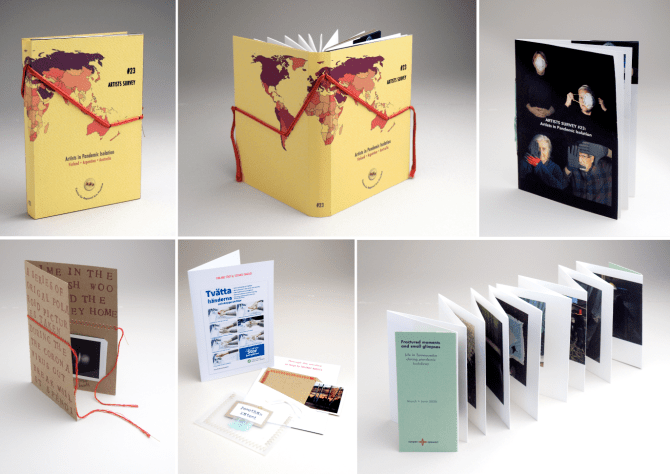



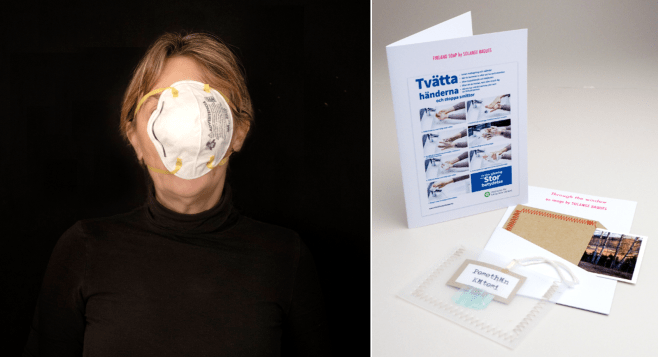
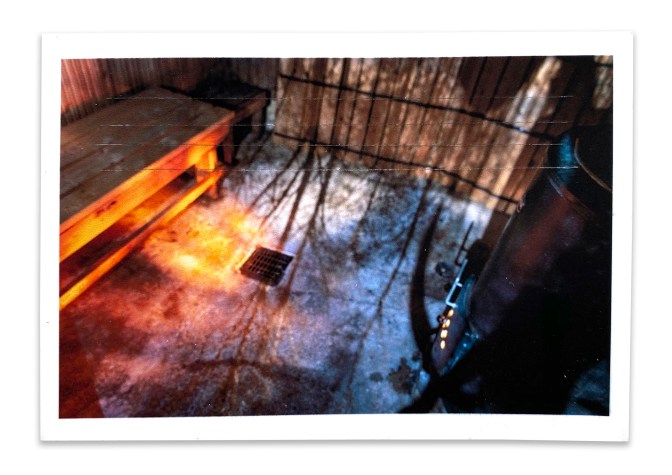

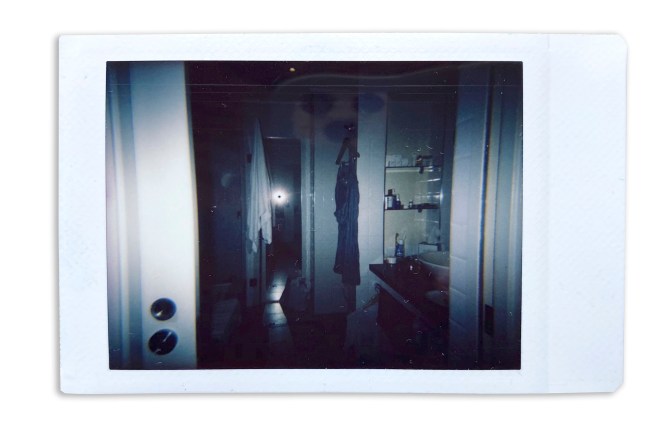
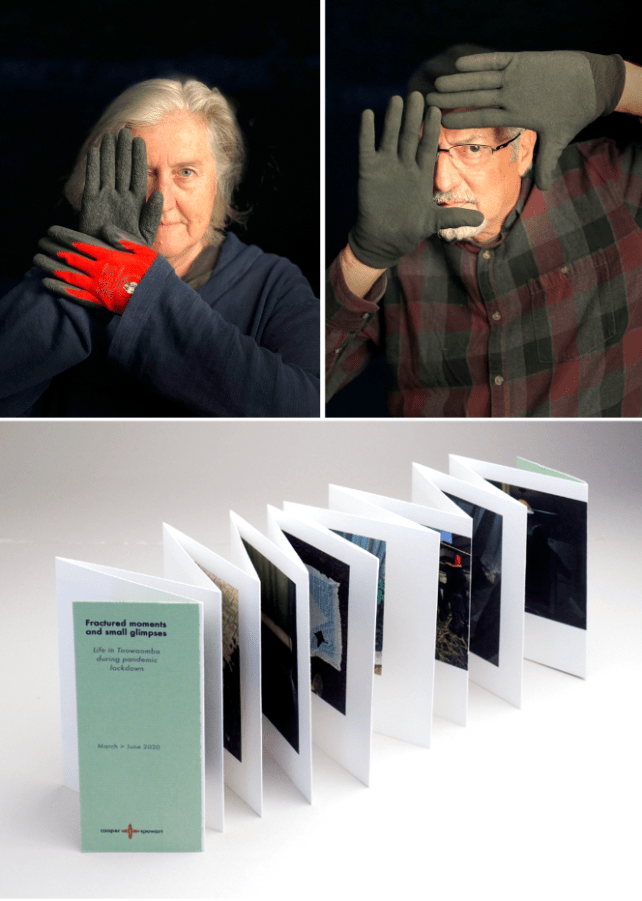
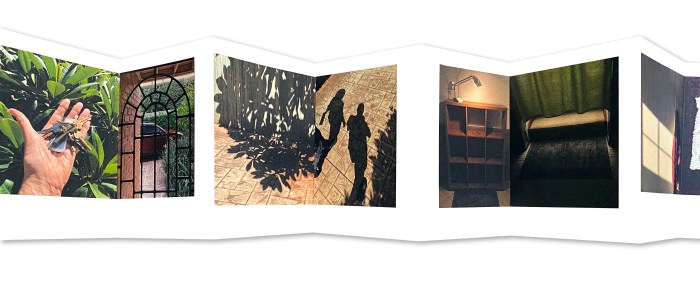
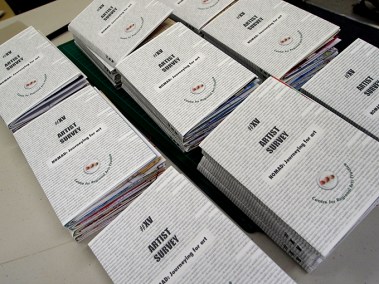














































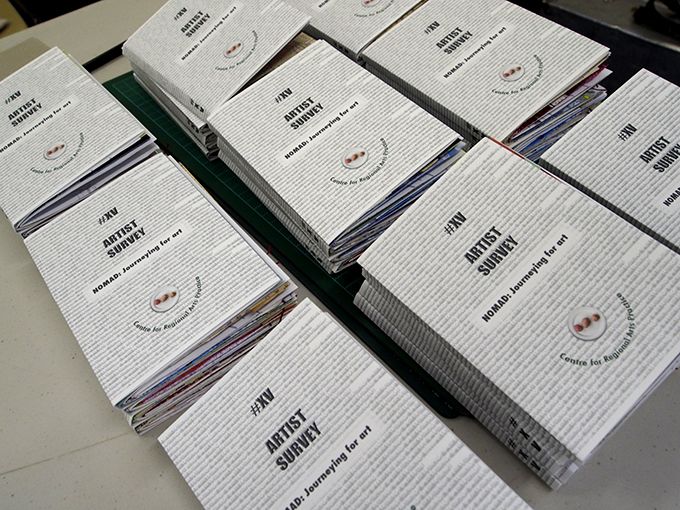

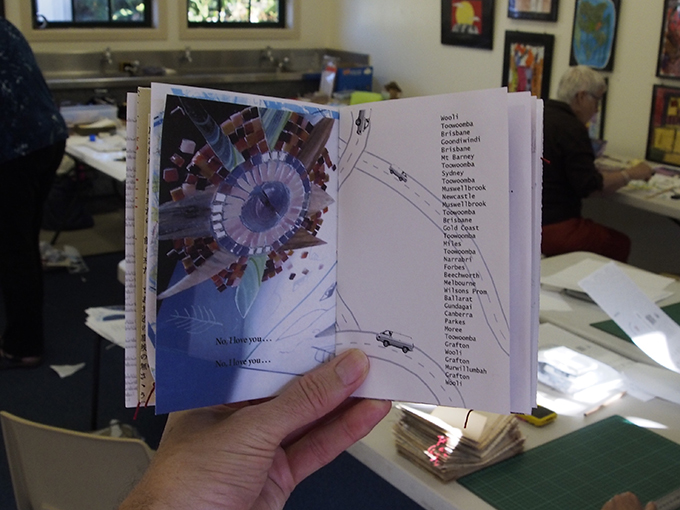
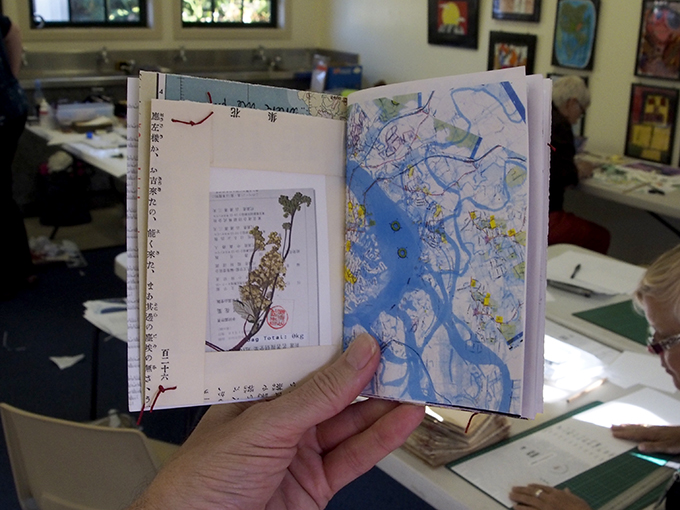
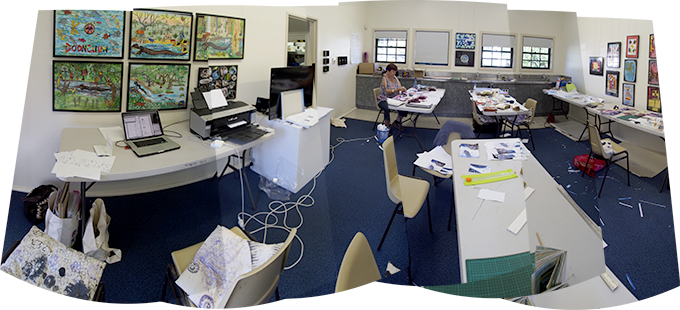
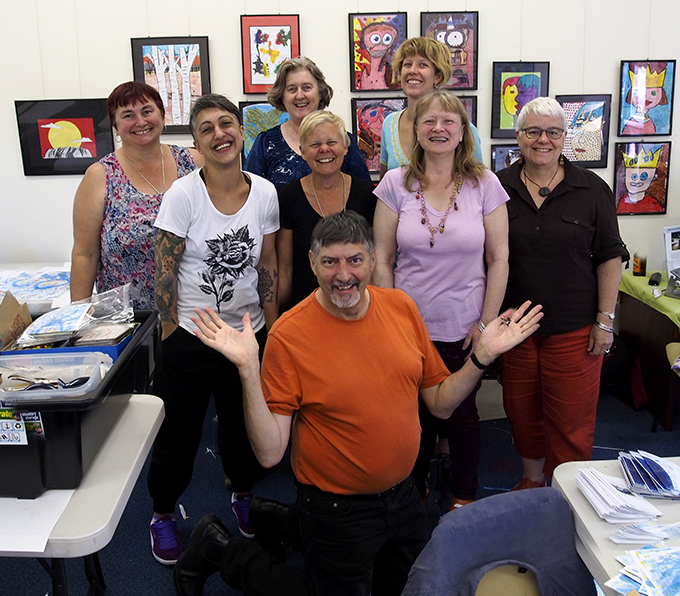
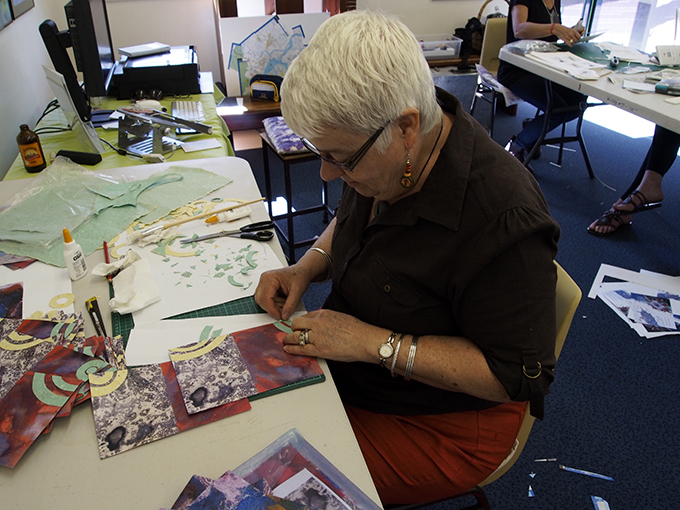
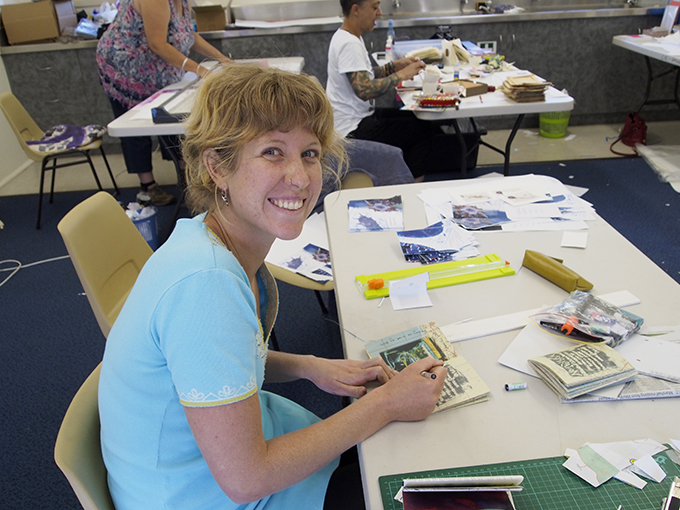

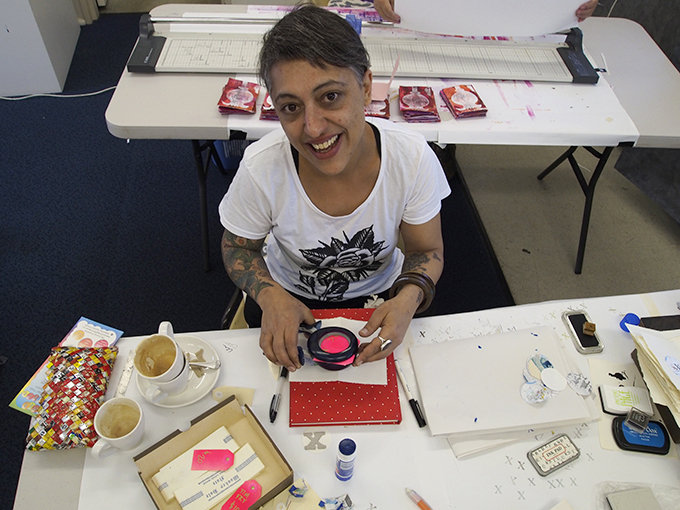

COMMENTARIES: ARTISTS BOOKS … AS POPULAR AS TATOOs!
leave a comment »
The wide view
COMMENTARIES ARISING FROM THE SLQ SIGANTO FOUNDATION SEMINAR
The trouble with artists’ books
State Library of Queensland – May 4, 2013
.
The quote “artists’ books … as popular as tatoos” was an opening remark by gallerist Noreen Grahame
.
In Volume 7 of the Bonefolder e-journal I reported on the dual artists book events of the 2010 Artspace Mackay Focus on Artists Book V, event and the 3rd Libris Awards. In this report I commented on the speaker’s presentations and reviewed the artists book award. I then concluded that these events were integral to the development and maintenance of a community of practice for those who make artists books in this country. Three years on the energy and enthusiasm for artists’ books remains however the Mackay Focus event has been abandoned and some awards events have slipped from their usual place in the yearly/bi-yearly calendar.
We are indeed indebted to the Siganto Foundation and the SLQ who in 2012 made possible the Keith Smith and Scott McCarney workshop and seminar, and this year the The trouble with artists’ books seminar. It seems to me that artists book community in this country has a great appetite for information, connecting with the heroes and heroines of the discipline, learning about methods and techniques as well as participating in camaraderie with their peers. My concluding words in the Bonefolder report recognised the importance of events such as Artspace’s Focus on Artists Books and the Libris Awards as they invigorate the discipline and the art of artists books … The significant response to this seminar indicates that the pace and frequency of artists book events should not slacken – we want more!
The Bonefolder report concluding comments were:
Awareness of the origins of the discipline of artists’ books and the Australian context as well as issues of contemporary and emergent practice is a unique outcome for FOAB. Where else in Australia this year would one be able to experience, or participate in a program where issues as diverse as Avatars making books in their second life, the death of the book/author, wild books and zoo viewing of books, propositions for new perceptive literature, mail art and the products of psychometry being resolved as artists’ books? Perhaps attendees should be warned of the ride that they would encounter.
Central to need for the FOAB, as an event, is its ability to pull together artists’ book interested people and provide a forum for them to be a part of something bigger than themselves. Artists’ bookmakers are individual artists, sometimes collaborators, librarians, academics, gallerists and collectors are isolated as islands of interest in their usual place of activity. But at FOAB they meet, greet, mingle, chat, discuss, argue and get down to the flensing-out of ideas, polemics and concerns about practice and the book as a work of art. This blend of interested parties forms the nucleus, the hub, of the discipline within this country – without it, there would only be individual soliloquies in the wilderness
.
Julie Barratt
Julie Barratt – Artist
I guess really briefly what I got from ‘the trouble with artist book ‘ talk if I was going to quote is ” it seems the trouble with artist books is that there are too many to love!!!” On a more serious note I guess for me it always comes down to how we talk about/define an artist book, as an ongoing discussion.
Almost on a daily basis when I had the gallery (I always had at lead a few artist books on display) people would ask what these books are! How to define them without quoting Johanna Drucker? Should there be categories i.e. Sculptural, digital etc etc. How do we expect the audience to understand them if we as practitioners have difficulty talking about them? But how do we agree on a definition?
That’s what I imagined the forum to be about because ‘isn’t that the trouble with artist books’? Having said that I thoroughly enjoyed the forum and think there need to be many many more of them when in fact there seem to be less (Mackay forum? ) so that the discussion can continue….
Its always a pleasure to catch up with the artist book community, feels like a reunion every time!
Julie
.
Maureen Trainor
Maureen Trainor – Photographer and QCA Masters student
I found these presentations to be very informative and inspiring.
The content and sequence of the presentations were dynamic.
By breaking down the delivery into the three different viewpoints the three Keynote speakers were engaging and thought provoking.
Starting with Helen Cole presenting ‘the Librarian’s view’, Noreen Grahame presenting ‘the Gallerist’s view’, Jan Davis presenting ‘the Artist’s view’ and ending with an interactive audience time for ‘questions and answers’ was right on target with information.
The Hearsay team discussing their project was fantastic. Combined with humour and wit they certainly kept the attention of a diverse audience.
I truly enjoyed the afternoon and felt I could of stayed into the night with more speakers and presentations.
Maureen
.
Monica Oppen
Monica Oppen – Artist and collector
The Trouble with Artists’ Books (and the Libris Awards)
Coming away from the SLQ seminar where the attendance was so strong and having attended the opening and announcement of the Libris Award at Artspace Mackay the conviction that has risen strongly in my mind is that there is a real need for events such as the SLQ Siganto Seminar. The strong attendance not only indicates a real interest in the topic but a desire of artists to reconnect with others working in the field. As Helen writes in her post about the Libris Awards, and I can vouch for it, there were very, very few artists there but also no other significant persons from the institutions who have an ongoing interest and involvement in artists’ books were there. The tyranny of distance and the associated costs of travel and accommodation will only be overcome by creating an event that is worth travelling for.
The topic The Trouble with Artists Books is pertinent and complex and was way too big to handle in one afternoon; a multi-day conference could have been structure around this topic. Time restrictions meant that Jan Davis and Noreen Grahame could only touch on, hint at and introduce the work/books from which a broader discussion could have expanded. The sense that there is a need for these seminars (judging from the attendance numbers) also hopefully indicates a need for more rigorous, mature critical discourse around the genre, a breadth of conversation and argument. Does the constant discussion of definition and the non-committal responses from ‘those who should know’ arise from this lack of discourse? I don’t consider the definition ‘if the artist calls it a book, it is a book’ to be an adequate, exciting nor empowering definition unless some force is allowed to work in opposition to it, that demands a justification, demands some critical analysis. The lines will always be blurry but this could be an energizing force and contribute a dynamism to the genre. By not taking a stand are we in fact leaving definitions to the gallery? Surely the gallery as a medium is the antithesis of the (artists’) book. The gallery is exposed and extraverted; the book is enclosed and introverted. Always it comes up, the problem with exhibiting artists books— this is because books are not meant to be exhibited, they are meant to be read. What are the implications for the genre if books are only viewed in the gallery, and more seriously if the gallery maintains a ‘no touch’ policy? Ironically, making a (artist’s) book was originally about abandoning the gallery; about the subversion of the commercialism of the art object. The book was meant to be a free-floating object in wider society. Where is that rebel spirit?
A hundred more questions could be asked. I hope the SLQ seminar is not a one-off but gives an impetus to more symposiums throughout the country.
Monica Oppen 14/5/13
.
Judy Barrass
Judy Barrass – Artist
THIS COMMENTARY COMES FROM JUDY’s BLOG – ‘Critical Mass’ http://www.criticalmassblog.net/2012/?p=2568
No one can agree on what they are, or even where the apostrophe should be placed, but a seminar on artists’ books at the State Library on Saturday drew a crowd.
It was a rare get-together of artist book makers and officianados, with attendees travelling from other states and regional Queensland just to attend the two-and-a-half-hour seminar and catch up with old friends.
According to the speakers, librarian Helen Cole, gallerist Noreen Grahame, and artist book maker and academic Jan Davis, artist books are problematic. That’s not just because no one seems to be able to agree on a definition, but also because they are hard to store, hard to display, and are not usually included in mainstream collections or exhibitions. They attract mostly a smallish group of makers and collectors and don’t sell in large numbers. Despite this, artists’ books draw a passionate audience of makers and supporters whenever they are on show (or whenever there’s a seminar).
Queensland has been a leader in the artist book phenomenon. The Queensland State Library is a significant collector, and Grahame Galleries took an early leading role. Artspace Mackay and Noosa Regional Gallery added public gallery support to exhibitions and collecting.
Someone suggested that it’s an inbred audience made up almost entirely of artist book makers, but a show of hands in the crowd on Saturday debunked this myth since at least half the attendees were not makers. Still, as Noreen Grahame remarked, artist books are a sort of ‘underground’ movement outside the mainstream.
I can’t help wondering if this is merely a question of naming. By calling these artworks ‘books’ they are relegated to the collections of libraries rather than art galleries, or they exist in a no man’s land between library and gallery. Nonetheless I have seen many works in public art gallery collections that could (or perhaps should) be called artist books. The boundaries are thin and flexible, and this was evident at the seminar. The mantra seems to be that if the artist calls it a book then it is a book.
One of the more interesting questions on the day was about the growing number of artist books that exist only in digital format. Helen Cole said the library was considering how these books might be collected and preserved, but indicated it was extremely difficult, particularly as technology changes so rapidly and formats and software become obsolete. Noreen Grahame solved the problem by referring to digital books as ‘ephemera’, and Jan Davis thought the number of artists working in the digital realm was small.
Following the discussion, a very chatty audience enjoyed a scrumptious afternoon tea and the launch of Hearsay, a large format collaborative artists’ book by artist Euan Macleod, printmaker Ron McBurnie, and writer Lloyd Jones. They apparently didn’t worry too much whether or not their work was or was not an artist book, but have sensibly hedged their bets by also producing the pages as a portfolio of unbound prints (in case anyone thought it wasn’t art, or more probably because the portfolio might be more saleable than an artist book ).
The seminar ‘The Trouble with Artist Books’ was sponsored by the Siganto Foundation through the Queensland Library Foundation.
The State Library artist book collection is part of the Australian Library of Art.
(Thank you Judy for allowing this re-posting in this blog)
.
.
Wim de Vos
Wim de Vos – Artist
‘The Trouble with Artists Books’
The lecture sponsored by the Siganto Foundation was very well attended by a large audience of art practitioners, administrators, and lovers of Artists Books, and was introduced by the new head of the State Library, Janette Wright. The speakers were Helen Cole, Senior Librarian of Special Collections at the Library; Noreen Grahame, Gallerist and long time respected promoter of the Artist Books within Australia and Internationally; and Jan Davis, Academic, and practitioner of Artists Books at Southern Cross University, Lismore, NSW.
Technically the lecture was informative, ran smoothly and was very well presented.
It was great to see so many practitioners (well over half the audience) and the general public, as this event facilitated a forum – to share, and some time to catch up with friends and colleagues. This has over the last few years become non-existent with the loss of the Art Space Mackay Artist Book Forum. Also the Noosa Regional Gallery’s ‘demise’ of the Artists Book annual exhibition was a sad occurrence. In addition, both venues offered successful workshops with renowned National and International Practitioners in the Visual Arts to nurture the visual arts and the book.
Many aspects of the development of Artists Books were addressed. Helen Cole addressed the ‘Trouble with Artists Books’ from a Librarian’s point of view, in that, because they were ‘Artists Books’ and diverse in so many ways, the logistics of preservation, cataloguing and storage were ‘Troublesome’. Furthermore, it was stated that the ‘Galleries’ had passed the Artists Books onto Libraries to display and make use of them, and by making Libraries the custodians of the ever-growing phenomenon of the Artists Book.
The concept of Artists Books is generally not an easy topic to present. It is in fact generally not understood at all. A friend recently pointed out, ‘I didn’t even know that an artist book existed, but as I have learnt through the language of art over time, I can say, I view this process as Book Works by Artists.’ A major exhibition of books of this nature: DAS BUCH was presented at the Queensland Art Gallery in association with the Museum of Contemporary Art in Sydney and the Goethe Institut in Germany during 1992. This was, I’m sure, a huge influence on art practitioners and the public. At the time, it placed an emphasis on the ‘Book as Object’ in a context never before experienced in the Antipodes. There has been no major exhibition of this type in a public gallery in this State, since.
As I am a practising artist and maker of prints, paintings, and sculpture, and work with a wide variety of materials, the book as object comes naturally as a medium to extend my practice. It has in fact tied together all my processes of making art, including text, giving me the freedom of story telling on many levels.
I observed, as the afternoon progressed, that in the presentation not all aspects of Artists Books practice was being fully covered and explored by the presenters. This became, indeed, troublesome. There is actually content within books, books with text, images and text, objects and materials, and so on. There was very little mentioned on the subject of the Sculptural Book or the Photo Book. A visual list WAS presented with images of the types of books that were in the collection of the Library. But no further elaboration was offered to those in the audience that were not already ‘in the know’. The State Library of Queensland has one of the largest collections of Creative & Historical books in the southern hemisphere.
Let it be said that we can be proud of a comprehensive, diverse, eclectic and public collection of books – particularly in the collection of Contemporary Art practice in Queensland and beyond. It is promoted that it ‘may be visited at any time, by appointment’.
I recognise that there is not time to cover everything fully. This made duplication and repetition even more irritating. Time may have been used more productively.
The lecture continued with the history of the Artists Book and it’s growth within Australia over the last 30 odd years. This painted an impressive picture of collections and practise over that time. Artists were mentioned who were instrumental in its development, but presenters did not go far enough on this issue, and failed to mention key motivators: artists both local and international. There was a ‘flow of words’ promoting a few artists over and over again. When the presentation of ‘Favourite Artists Books’ was introduced the theme of the lecture was totally abandoned. We were presented with a self-indulgent diversion as to what the book may mean only to the ‘literate Artists Book fans’ present.
It would have been more useful to give the audience an indication of how they may wish to learn more about Artist Books through the public and private system. There was enough talent and experience behind the microphone to impart this information. It seemed much of this lecture was preaching to the converted.
Afternoon tea on the terrace was followed by the launch of a collaboration of an Artist Book created by two well-known visual artists: Ewan McCloud and Ron McBurnie, and the writer Lloyd Jones. This was a very good presentation chaired by Suzi Muddiman: Director of the Murwillumbah Regional Art Gallery in NSW. This gave the opportunity for the layperson to experience the processes of collaboration in art making.
As there are no indications of any follow-up lecture or activities relating to Artist Books, it would be worthwhile to plan something on the promotion and educational aspects of Artists Books. I am sure it would be a great success.
A ‘large bouquet’ to Helen Cole in particular, and the State Library, for organising this generally informative and pleasant afternoon. We look forward to a more expansive event in the future.
Wim de Vos
.
.
Peter Lyssiotis
Peter Lyssiotis – Artists book-maker and photomonteur
Peter’s letter
.
A vodcast for the event is available at http://www.slq.qld.gov.au/audio-video/webcasts/recent-webcasts/siganto-seminar
.
Cheers Doug+Victoria
.
.
© Of all texts resides with the authors
Photograph of the SLQ Theatre, Julie Barratt, Monica Oppen, Wim de Vos © Doug Spowart 2013. Self-portrait of Maureen Trainor ©2013. Judy Barrass portrait supplied by Judy.
This work is licensed under a Creative Commons Attribution-NonCommercial-NoDerivs 3.0 Unported License.
.
.
.
Share this:
Written by Cooper+Spowart
June 3, 2013 at 1:56 pm
Posted in Artists Books, Meeting People, Reviews, Wot happened on this day
Tagged with Artists Books, artists' books in Australia, Artspace Mackay, Bonefolder e-journal, commentary on artists books, communities of practice, communities of practice artists books, Focus on Artists' Books, Helen Cole, Judy Barrass, Julie Barratt, Libris Awards, Maureen Trainor, Monica Oppen, Peter Lyssiotis, Siganto Foundation, State Library of Queensland, the trouble with artists' books, Wim de Vos